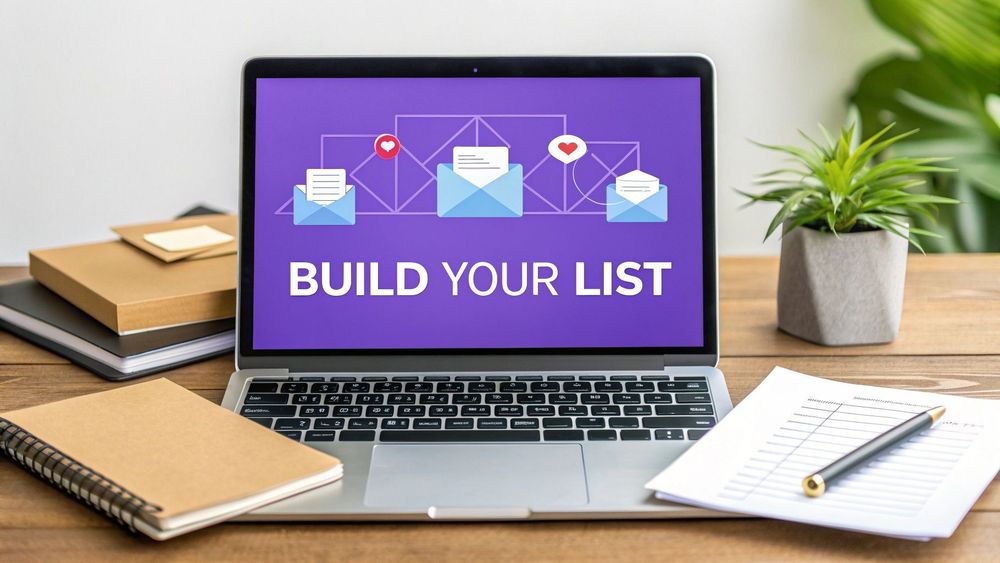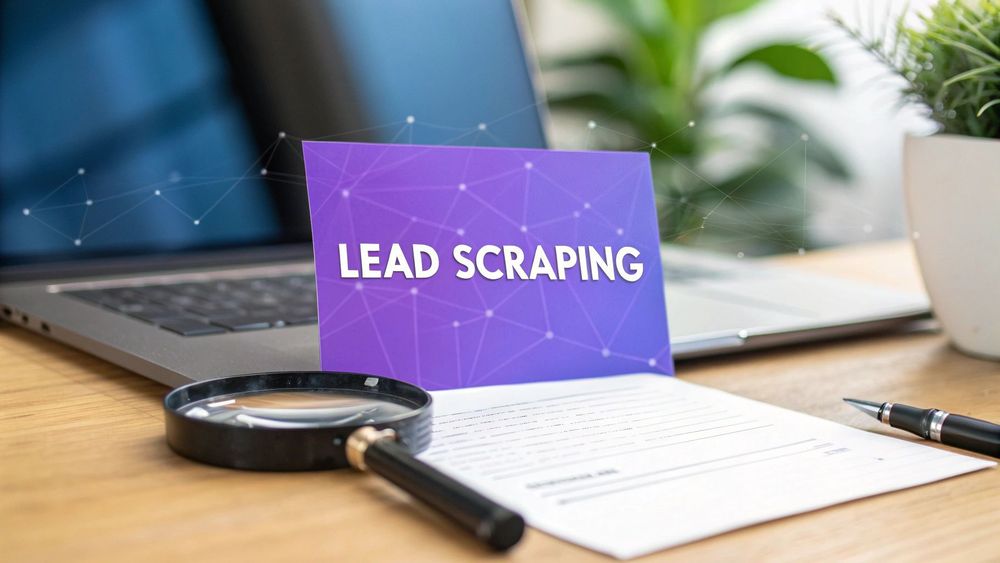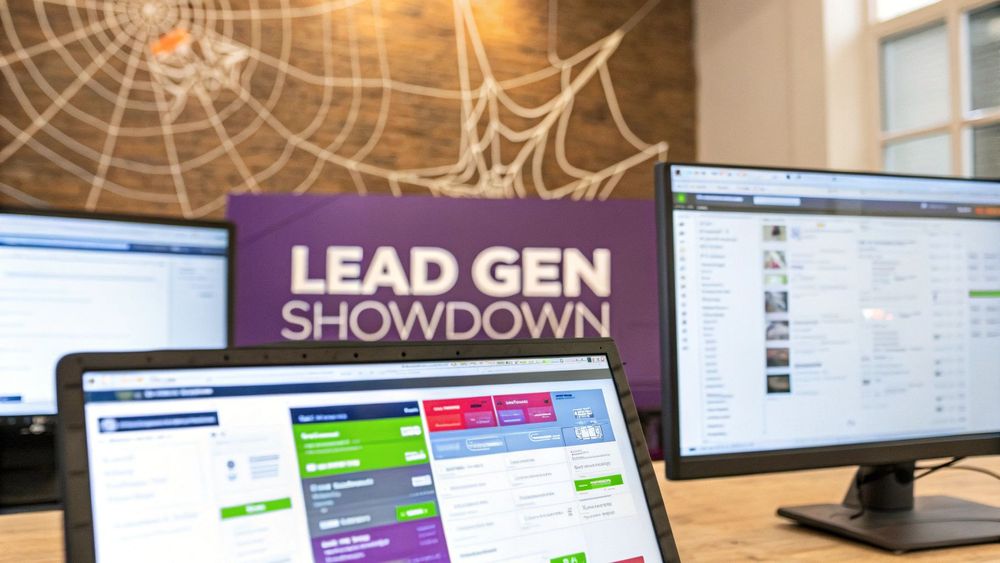Building an email list comes down to one core idea: offering genuine value in exchange for a direct line of communication. It's about creating a relationship by providing something your audience actually wants, not just collecting contacts.
Why an Email List Is Your Most Powerful Asset
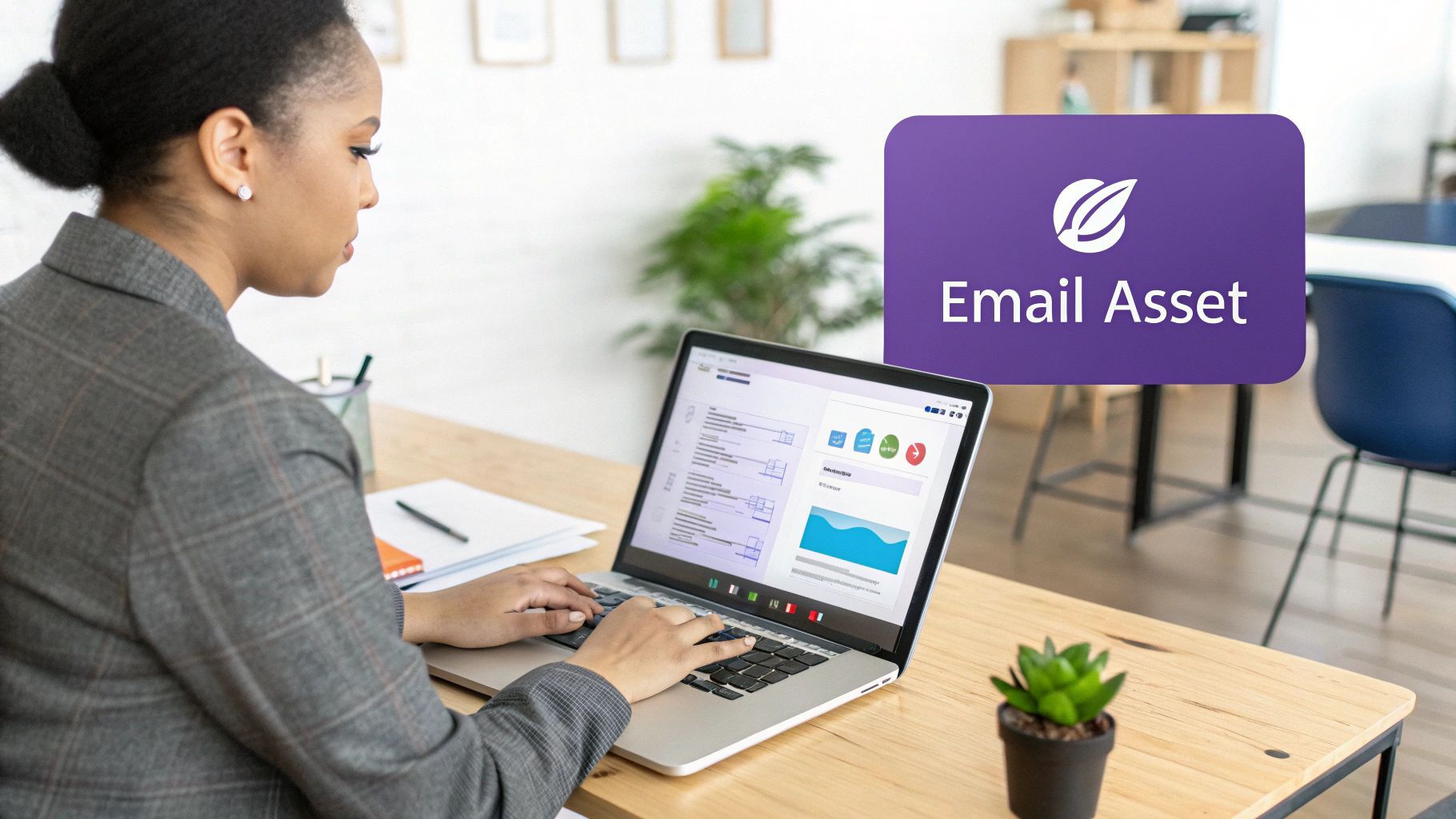
Before we get into the how, let’s talk about why. Why is an email list such a big deal? Simple. Unlike your social media followers or search rankings, your email list is something you actually own.
Think about it. Social media algorithms can change overnight, wiping out your reach. But your email list? That’s a stable, direct line to the people who are most interested in what you have to say. For sales professionals, that's a pipeline of warm leads. For recruiters, it's a private talent pool you can tap into anytime.
The Value of a Direct Connection
When was the last time you launched a new service or had a critical update to share? An email ensures that message lands right in their inbox, cutting through the noise of crowded social feeds. You're not competing for attention; you've already got it. This direct line is where real relationships are built and where you can get invaluable feedback straight from the source.
An email list isn't just a database of contacts; it's a community you've built. These are the people most likely to read your content, buy your products, and tell others about you.
This connection isn't just a warm fuzzy feeling—it delivers real, predictable results. We're talking about a massive scale of communication, with over 347 billion emails sent and received every single day. Even with that volume, email marketing pulls in an incredible average return of $42 for every $1 spent. If you're curious, you can dig into more email marketing statistics that prove why it’s still one of the most powerful channels out there.
More Than Just a Marketing Channel
If you're only thinking about your list as a marketing tool, you're missing the bigger picture. It's an incredibly versatile asset that can power different parts of your business.
- For Sales Teams: You can segment your list by interest or where someone is in the buying journey. This lets you send highly targeted messages that gently guide them toward a sale without feeling pushy.
- For Recruiters: Imagine having curated lists for different roles, like software engineers or marketing managers. When a new position opens up, you have a pool of qualified candidates ready to go.
- For Marketers: This is your playground for A/B testing. Try out different subject lines, offers, and calls to action to see what really clicks with your audience. You get real data to sharpen your entire strategy.
Ultimately, building a high-quality email list is about creating a sustainable engine for growth. It’s an investment that pays you back over and over through more sales, stronger client relationships, and a much more stable business in the long run.
Setting the Foundation for Sustainable List Growth

Jumping into list building without a solid plan is a recipe for wasted effort. The most successful email lists are built on a strong foundation, not just a random collection of signups.
This groundwork really comes down to two things: understanding exactly who you're talking to and picking the right tools for the job. Get these right, and everything else falls into place.
It all starts with your ideal subscriber. Before you write a single welcome email or design an opt-in form, you need a crystal-clear picture of this person. Who are they? What keeps them up at night? What kind of content would make them stop scrolling and actually pay attention?
Defining Your Ideal Subscriber
Creating a detailed persona for your ideal subscriber is a non-negotiable first step. This isn't just about basic demographics; you need to get into their heads to understand their motivations and pain points.
Let's make this practical for a recruiter:
- Ideal Subscriber: A passive candidate, like a senior software engineer with 5+ years of experience in Python.
- Pain Point: They feel stagnant in their current role, lacking challenging projects and growth opportunities.
- Motivation: They are looking for a role with greater impact, better compensation, and a modern tech stack.
By defining this, a recruiter knows exactly what kind of content to create—like an exclusive guide on "How to Negotiate a Senior Tech Salary" or a "Checklist for Vetting Your Next Engineering Role." This level of detail dictates every single thing that follows, from the lead magnets you create to the subject lines you write. It's how you attract people who will actually open, read, and benefit from your messages.
Choosing Your Email Service Provider
With a clear picture of your subscriber, the next piece of the puzzle is selecting an Email Service Provider (ESP). This is the command center you'll use to manage your list, send out campaigns, and see what's working.
While there are tons of options out there, you want to focus on features that will help you grow. Look for an ESP that offers robust segmentation, allowing you to group subscribers based on their interests or how they've interacted with your content.
Automation is also a game-changer. The ability to set up automated welcome sequences or nurture campaigns will save you an incredible amount of time. If you're using WordPress, exploring a dedicated tool like the Constant Contact WordPress plugin for email marketing can seriously boost your efficiency right from the start.
A great ESP grows with you. Don't just pick one for where you are today. Think about where you want to be in a year and choose a platform that can support those goals. That means looking at its integration capabilities and how well it plays with your other tools.
Speaking of integrations, connecting your ESP with effective contact management software is a pro move. Having one central hub to organize your leads and subscribers prevents data from getting scattered across different platforms and gives you the full picture of your audience. You can learn more about finding a solution that fits your workflow by checking out the best contact management software.
Finally, you need a plan for your opt-in forms. These are the front doors to your list. High-converting forms are simple, clear, and offer undeniable value in exchange for an email address.
Place them strategically on your site—in the footer, at the end of blog posts, or as a non-intrusive pop-up that appears when someone is about to leave. The goal is to make signing up feel like a welcome invitation, not an annoying interruption.
Real Strategies to Get Your First 1000 Subscribers
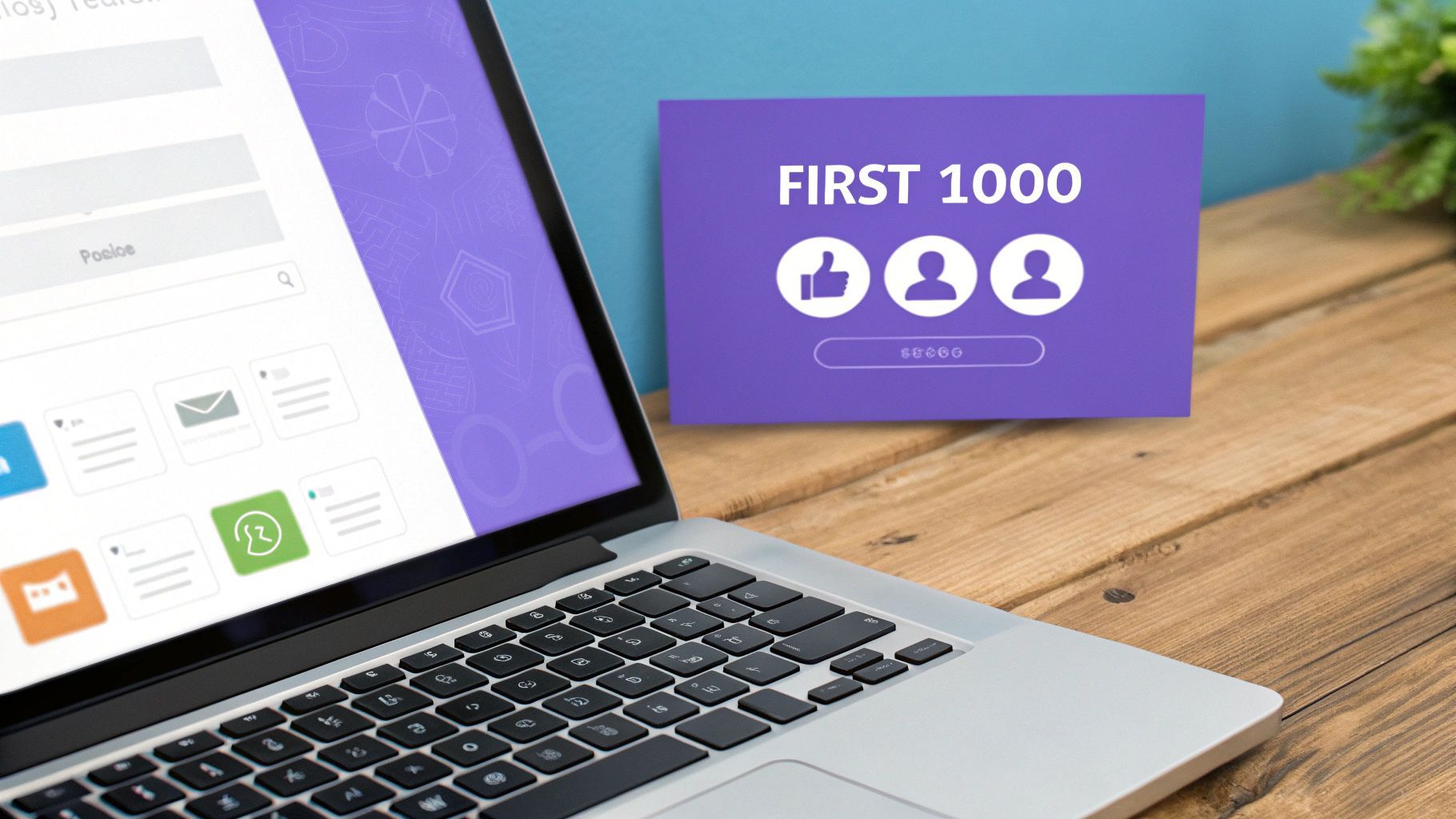
Hitting that first milestone of 1,000 subscribers can feel like a mountain to climb, but it's completely doable with the right playbook. This is where you graduate from theory to seeing real, tangible results. The secret is to zero in on tactics that give your ideal subscriber immediate, undeniable value.
Let's start with your home base: your website. It's your prime real estate for capturing leads, but you need to give people a seriously compelling reason to hand over their email. That reason is your lead magnet—a high-value freebie offered in exchange for an email address.
Create Irresistible Lead Magnets
Forget the generic ebooks everyone else is peddling. The best lead magnets solve a specific, urgent problem for your audience. You need to get inside their head, figure out what they truly need, and create something they can use right now.
- Practical Checklists: A "10-Point LinkedIn Profile Audit Checklist" for job seekers.
- Useful Templates: A "Cold Outreach Email Template" for sales professionals.
- Mini-Courses: A three-part video series on "Effective Talent Sourcing" for recruiters.
- Resource Guides: A curated list of the "Top 10 Research Tools for Marketers."
The more practical and actionable your lead magnet is, the more sign-ups you'll get. If you want to see what's working for others and get some inspiration, check out these powerful lead generation examples that you can easily adapt for your own list-building efforts.
Fast-Track Your List with Targeted Outreach
For recruiters, sales professionals, and marketers, waiting for website sign-ups is too slow. You often need to build a targeted list of prospects or candidates now.
The Traditional Method: Manual Scraping Let's say you're a recruiter who needs to build a list of 50 potential software engineers from LinkedIn. The old-school way is painfully slow:
- Run a search on LinkedIn.
- Open each profile in a new tab.
- Manually copy and paste their name, job title, company, and location into a spreadsheet.
- Try to find a contact email, which is often hidden or unavailable.
- Repeat this process 50 times. It's tedious, error-prone, and burns hours you could be spending on actual outreach.
The Modern Solution: One-Click Extraction This is where a no-code, AI-powered tool completely changes the game.
Instead of spending an entire afternoon manually scraping 50 profiles, you can use ProfileSpider to extract hundreds of accurate, complete profiles from any website with a single click.
It simplifies the workflow down to its essence:
- Navigate to a LinkedIn search result page, a company's team page, or any online directory.
- Click the ProfileSpider extension icon.
- AI-powered extraction instantly identifies and pulls all professional data—names, titles, companies, social links, and contact info—into a clean, structured list.
There's no setup, no configuration, and no coding required. It's a universal extraction engine that saves hours of manual work, giving you an exportable CSV or JSON file in seconds. This allows you to quickly build a foundational list for your initial campaigns and feed a steady stream of qualified contacts right into your email nurturing sequences. You can learn more by reading our guide on lead generation best practices.
Advanced Tactics to Accelerate Your List Growth
Okay, you've got the foundation in place. Your first subscribers are starting to trickle in. Now what? It's time to hit the accelerator.
Moving beyond the basics means shifting your mindset from slow, linear progress to explosive, exponential growth. This is where you pour some fuel on the fire and really start to see things take off.
This infographic hammers home the difference between a generic, site-wide offer and a hyper-targeted one. It also gives you a peek into where most of your high-quality subscribers will come from as you scale up.
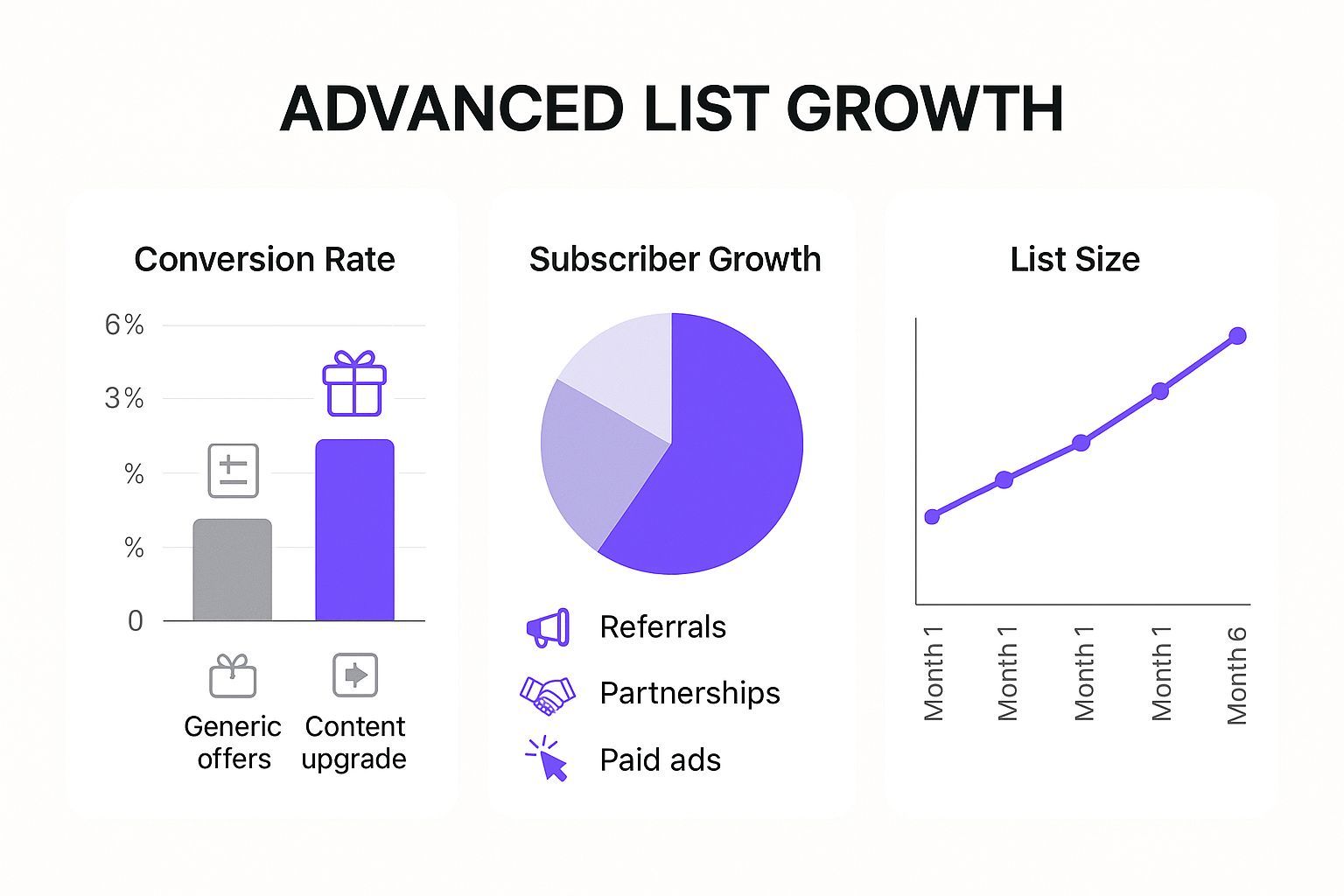
The data is pretty clear: if you want to scale your list quickly, you need to get surgical with your offers and diversify how you bring people in.
Leverage the Power of Content Upgrades
A content upgrade is a bonus resource offered within a specific blog post that's directly related to what the person is reading right now. Instead of a generic, "Download our Ultimate Guide" pop-up that shows up everywhere, you're offering something that perfectly complements the topic at hand.
Think about it. A sales pro reading an article about cold outreach is far more likely to grab a "Top 5 Cold Email Templates" PDF than some vague, site-wide "Guide to Sales."
This laser-focused relevance is why content upgrades can convert 10-20 times better than generic lead magnets. You're meeting the reader exactly where their interest is at its peak.
Turn Subscribers into Advocates
Your most dedicated subscribers can easily become your best marketers. You just have to give them a reason. A smart referral program or a well-run giveaway can transform your list into a growth engine that basically runs itself.
- Referral Programs: Offer a genuinely valuable incentive—like a discount, exclusive content, or an extended trial—to subscribers who get their friends to sign up.
- Giveaways: Run a contest where people get extra entries for sharing it with their network. This can create a viral loop that rapidly expands your reach beyond your own audience.
Form Strategic Partnerships
You don't have to build your audience in a vacuum. Teaming up with a complementary business is one of the fastest ways to tap into a pre-built, relevant audience that's ready to hear from you. Co-hosting a webinar is a classic for a reason—it works.
By collaborating with another business that serves a similar audience but doesn't directly compete, you both provide immense value and get exposure to a warm, qualified pool of potential subscribers.
This approach is so effective because you get to borrow the trust your partner has already built with their audience. It's an instant credibility boost. With email usage projected to hit 4.6 billion active users by 2025, the potential audience is massive, and partnerships are a shortcut to reaching them.
Invest in Paid Acquisition
Organic growth is fantastic, but it's often a slow burn. When you're ready to really scale, investing in paid channels like Facebook or LinkedIn Lead Ads can deliver a steady stream of highly targeted subscribers on demand.
These ad formats are brilliant because they let users subscribe with just a couple of clicks, right inside the platform. This slashes the friction and sends conversion rates through the roof.
By sending this traffic to a dedicated squeeze page with an irresistible offer, you create a predictable, scalable system for growing your list. You can even automate the entire follow-up sequence. (Our guide on marketing automation workflow examples has some great templates to get you started on that.) This is how you turn list building from a guessing game into a calculated investment with a measurable return.
Keeping Your Subscribers Engaged and Happy
Getting someone to sign up for your email list is just the starting line. Honestly, a huge list size doesn't mean much if your open rates are in the single digits. The real work starts the moment they subscribe—turning that brand new contact into a loyal fan who actually looks forward to your emails.
This all begins with a killer welcome sequence. This isn't just one email; it's your single best chance to make a fantastic first impression. Think of it as a series of two or three messages that roll out the red carpet, set expectations for what's coming, and deliver some kind of immediate value.
Send the Right Message to the Right Person
As your list starts to grow, blasting the same email out to everyone just stops working. This is where you need to get smart with segmentation. All that means is splitting your list into smaller, more focused groups based on things like their interests, what they've bought, or how they interact with your content.
Imagine a recruiter who sends a generic "hot jobs" email to their entire list. It's going to fall flat. But what if they segment that list into "Software Engineers" and "Marketing Managers"? Now they can send super-relevant opportunities that people will actually click on.
This isn't just a nice idea; the numbers are pretty dramatic. Detailed segmentation has been shown to boost open rates by 30% and click-through rates by a whopping 50% compared to those generic email blasts. It's no surprise that 78% of marketers swear by it. You can dig into even more email marketing statistics on VIB.tech if you're curious.
So, how do you actually put segmentation into practice? There are a bunch of ways, but here are a few you can start with right away:
- By Interest: Group people based on the lead magnet they downloaded or the blog categories they read the most.
- By Purchase History: Create different buckets for first-time buyers, repeat customers, and your high-value VIPs.
- By Engagement Level: Identify your superfans (the ones who open everything) and those who've gone quiet for 90 days.
To give you a clearer picture, I've put together a table breaking down some of the most effective ways to slice and dice your list.
Effective Email List Segmentation Strategies
| Segmentation Type | Basis for Segmenting | Example Use Case | Recommended Content |
|---|---|---|---|
| Demographic | Age, gender, location, job title | A clothing brand targeting women aged 25-35 in urban areas. | New arrivals, style guides, and promotions relevant to their city. |
| Behavioral | Purchase history, email engagement, website activity | An e-commerce store sending a special offer to customers who haven't purchased in 6 months. | "We miss you" discount, product recommendations based on past buys. |
| Interest-Based | Content consumed, lead magnet downloaded | A SaaS blog sending tips to users who downloaded a "Productivity Cheatsheet." | Advanced productivity hacks, webinar invitations on time management. |
| Lifecycle Stage | New subscriber, repeat customer, lapsed user | Sending a "getting started" guide to someone who just signed up for a free trial. | How-to videos, case studies, exclusive upgrade offers. |
As you can see, each strategy helps you tailor your message so it resonates more deeply with a specific slice of your audience. The more relevant you are, the better your results will be.
Practice Smart List Hygiene
Finally, a healthy list is a clean list. It's just a fact of life that some subscribers will go cold over time. People change jobs, switch to a new email, or simply lose interest. If you keep sending emails to these unengaged contacts, you're actually hurting your sender reputation and your overall deliverability.
That's why list hygiene is so critical.
At least once or twice a year, you should run a re-engagement campaign to try and win back those inactive subscribers. For anyone who still doesn't respond, it's time to say goodbye. I know it feels weird to shrink your list on purpose, but clearing out the dead weight is one of the best things you can do. It ensures your emails land in the inboxes of people who genuinely want to hear from you, which in turn boosts all your important metrics and keeps your list responsive.
Got Questions? We've Got Answers
Even when you're following all the best practices, you're bound to hit a few snags or have questions pop up. It's just part of the process. Here are some of the most common hurdles I see people face when building their email list, along with some straight-up, actionable advice to keep you moving forward.
How Often Should I Email My List?
This is the golden question, isn't it? While there's no single magic number, a great starting point for most businesses is once a week.
The most important thing here is consistency. Seriously. It’s far better to send one genuinely valuable email every single Tuesday morning than it is to bombard your list daily for a week and then go silent for a month. That's a surefire way to get unsubscribes.
Start with a weekly schedule and keep a close eye on your metrics. Your open rates, click-throughs, and unsubscribe numbers will tell you everything. Your audience will show you what they want. Just remember to always, always prioritize quality over quantity.
What Is the Best Lead Magnet to Offer?
The best lead magnet is one that solves a specific, nagging problem for your ideal subscriber. It’s time to move past the generic, fluffy ebooks and think about creating practical, high-value tools they can use right now.
For example:
- Selling to other businesses? Offer a proven cold email template that actually gets replies.
- A recruiter trying to connect with talent? Provide a checklist for optimizing a LinkedIn profile to attract recruiters.
- In the data analytics space? Create a curated guide to the best free data analysis tools on the market.
The more tangible and immediately useful your offer is, the better it will convert. A great place to find ideas is to look at your most popular blog posts or think about the questions you get asked over and over again. The answer is usually right there.
Is a Large or Engaged List Better?
Let me be crystal clear: a small, engaged list is always more valuable than a massive, unengaged one. It’s not even close.
Engagement—measured by opens and clicks—is the true pulse of your list's health. It tells you that your subscribers are actually interested in what you have to say. These are the people who will eventually become customers and advocates for your brand.
Think about it this way: blasting emails to thousands of people who never open them doesn't just waste your time—it actively hurts your sender reputation. This tanks your deliverability, meaning even your most loyal fans might not see your emails in their primary inbox.
How Do I Get Subscribers Without a Website?
You absolutely do not need a full-blown, multi-page website to start building your list. Not at all.
All you really need to get the ball rolling is a simple, focused landing page. Use a straightforward tool to create a single page that clearly explains the value of your lead magnet and has a can't-miss sign-up form.
Once you have that page, promote it everywhere. Put the link in your social media bios. Add it to your professional email signature. Mention it when you're networking. This lets you start capturing valuable contacts and building that all-important audience, even if your main website is still just a sketch on a napkin.

